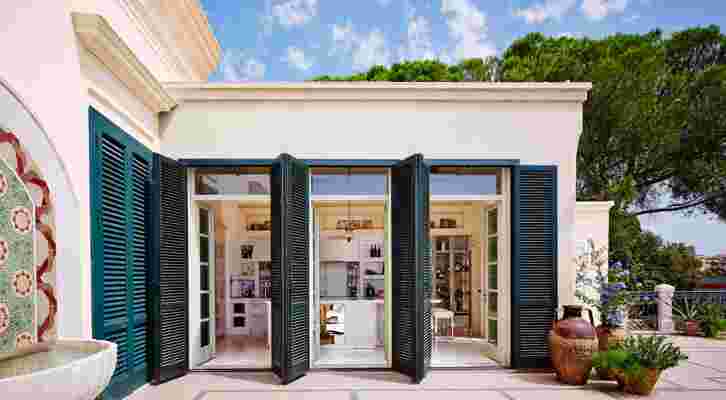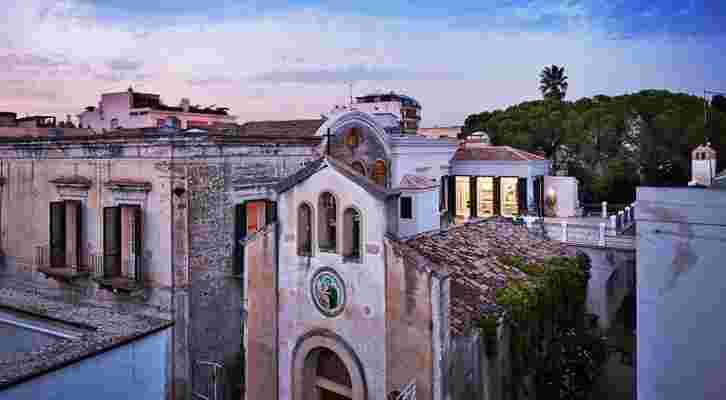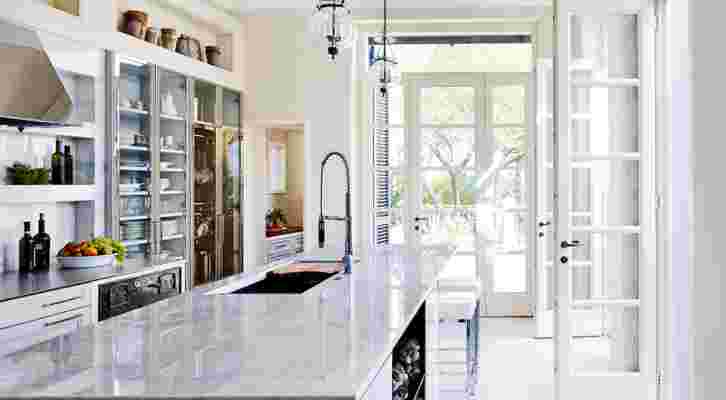Few places conjure more romantic visions of cooking and eating than Italy, a country synonymous with delicious tangles of pappardelle, savory hunks of Parmigiano-Reggiano, and, of course, glasses upon glasses of Montepulciano. The nation’s culinary traditions are certainly near and dear to the Coppola family, whose members have long called Bernalda, a hill town in the southern Basilicata region, home. Several years ago Donato Coppola—a London-based artisan known for bespoke architectural surfaces—and his wife, Elizabeth, set about renovating their 19th-century Bernalda residence, Palazzo Appio. Naturally, they wanted a top-notch kitchen where they could gather and cook with their large network of friends and relatives. (Donato’s filmmaker cousin Francis lives next door.) To realize a space that would be truly special, the couple turned to kitchen designer Mick De Giulio.
The Chicago-based De Giulio had long been fascinated with the architecture of southern Italy, his father having been born in Puglia. Thrilled by the assignment, the designer paid a visit to the Coppolas’ palazzo, only to find a dark 120-year-old kitchen that hadn’t been touched in decades. “It belonged to another era, when kitchens were for staff to cook in rather than places to entertain,” says De Giulio, who nonetheless saw great promise in the space. Within hours of his arrival, he had sketched a plan.
The results of that renovation, along with eight other recent projects, are the focus ofDe Giulio’s simply titled new release, Kitchen (Pointed Leaf Press). Coming out in November, it’s the follow-up to his successful 2010 book, Kitchen Centric. The featured spaces showcase De Giulio’s expert ability to wed refinement and functionality, none more so than the one he devised for the Coppolas, which also deftly merges indoors and out. Where once there had been a wall with only two small windows, De Giulio installed a series of French glass doors, accented by green shutters, that open onto an expansive terrace offering a vista of tiled rooftops and the Gulf of Taranto.



Eliminating that wall dictated where the refrigerator could be recessed, which subsequently determined the location of the island. It runs parallel to the French doors, giving the cook a prep space with stunning views. To place the other key appliances, De Giulio followed the rule of the work triangle, wherein the sum of the distances between the sink, refrigerator, and range should not exceed 27 feet. “It doesn’t always hold true,” he says, “but it did here.” Great design, he insists, is never simply a matter of math: “Instead of counting up how many spices clients have or calculating how much pantry space they need, I just listen to them.”
Having spent time with the Coppolas at their London home, De Giulio had observed firsthand that theirs is a family of cooks. In anticipation of multiple sets of hands preparing any given meal, he incorporated two sinks. The main one, on the island, is a single well (he prefers a relatively shallow depth of seven to eight inches) that includes an inset knife sharpener as well as a sliding cutting board, colander holder, and flatware tray. The smaller secondary sink resides under the pot filler, a necessity in a kitchen where pasta meals regularly call for boiling water.
For storage, De Giulio went with his signature Metal Boy cabinets, tall glass-front pieces that display neatly stacked dishware on white shelves and cookware on large hooks. “We lined the interior of one cabinet with distressed nickel silver,” he explains. “Pristine new metal would highlight the flaws of pots and pans that have been lovingly used.” The countertops, meanwhile, are a mix of stainless steel (flanking the range) and, on the island, polished Carrara marble. “In Italy, they’re accustomed to using marble as a worksurface,” he says of the porous, stain-prone stone. “They let it go. It is a kitchen after all.” Tiles of the same material sheathe the backsplash and niches.
As dramatic as the transformation was, some vestiges of the former kitchen remain. The cast-iron doors from the antique ovens, for example, now embellish the lower cabinets. “It’s a very old house, but the kitchen bridges the past and the present,” observes Elizabeth Coppola. “Mick struck just the right tone."
